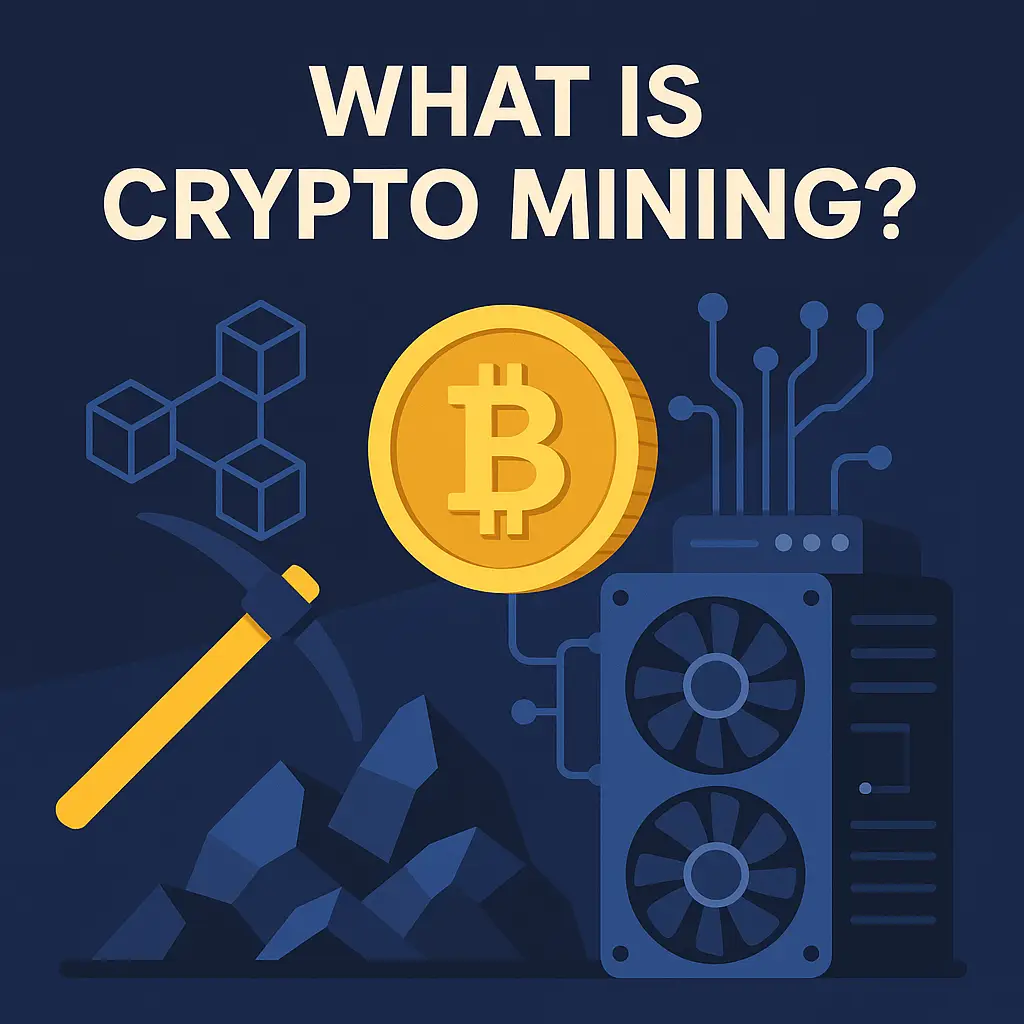Introduction
Crypto mining is the foundation of many cryptocurrency networks, especially Bitcoin. It not only helps create new coins but also keeps the blockchain secure and decentralized.
If you’re new to crypto, understanding what crypto mining is, how it works, and whether it’s profitable in 2025 can open the door to exciting opportunities. In this guide, we explain how crypto mining works, what you need, types of mining, and more — in simple terms.
Whether you want to earn Bitcoin or just learn, this article will help you get started the right way.
🧠 What Is Crypto Mining?
Crypto mining is the process of validating cryptocurrency transactions and adding them to the blockchain. In return, miners earn rewards in the form of digital currencies.
Think of it like digital bookkeeping powered by high-performance computers. Instead of a centralized bank confirming transactions, it’s done by a global network of miners.
⚙️ How Does Crypto Mining Work?
Mining ensures transactions are verified and stored in an immutable public ledger. Here’s how it works:
- Users initiate crypto transactions.
- Transactions are grouped into a block.
- Miners solve a complex puzzle (hash function).
- The first to solve it adds the block to the blockchain.
- The miner is rewarded with cryptocurrency + fees.
This process uses the Proof of Work (PoW) consensus mechanism — a secure and decentralized model.
🏆 What Are Mining Rewards?
Crypto miners earn two types of rewards:
- Block rewards – New coins issued to the miner (e.g., 6.25 BTC/block).
- Transaction fees – Collected from users to prioritize their transactions.
Block rewards reduce over time due to events like Bitcoin halving, making mining more competitive.
🛠️ What You Need to Start Crypto Mining
💻 Hardware
- ASICs – Ultra-powerful, used for Bitcoin mining.
- GPU mining rigs – Best for altcoins (e.g., Litecoin, Dogecoin).
- CPU mining – Outdated but used in specific networks like Monero.
⚙️ Software
- Programs like CGMiner, NiceHash, or EasyMiner.
🔐 Wallet
- Secure storage like Ledger, MetaMask, or Trust Wallet.
🔌 Power + Internet
- Mining requires consistent power and strong internet bandwidth.
🔄 Types of Crypto Mining
There are various ways to mine cryptocurrency, depending on your resources and goals:
1. Solo Mining
You mine independently. Profits are higher, but so is the cost and difficulty.
2. Pool Mining
Miners combine resources and share rewards. Ideal for small or beginner miners.
3. Cloud Mining
Rent computing power remotely. It’s easy to start, but beware of scams.
4. ASIC Mining
Special hardware designed for speed and efficiency, mainly for Bitcoin.
5. GPU Mining
Widely used for altcoins like Ethereum Classic and Dogecoin.
🧮 Mining Difficulty & Hash Rate
The more miners join the network, the harder it gets to solve the puzzle — this is mining difficulty. It ensures steady block creation.
- Hash rate = how fast your hardware solves blocks.
- Higher hash rate = better chance of rewards.
🏭 What Are Mining Pools?
Mining pools are groups of miners working together to increase reward chances.
Top mining pools include:
- Slush Pool
- F2Pool
- AntPool
✅ Pool mining helps stabilize your earnings, especially if you don’t own powerful hardware.
🔍 Crypto Mining Algorithms
Different coins use different hashing algorithms, which influence hardware compatibility.
| Coin | Algorithm | Mining Type |
|---|---|---|
| Bitcoin | SHA-256 | ASIC |
| Litecoin | Scrypt | ASIC |
| Dogecoin | Scrypt | ASIC/GPU |
| Monero | RandomX | CPU/GPU |
Knowing the algorithm helps you choose the best equipment.
🧮 How to Calculate Mining Profitability
Before mining, estimate earnings using tools like:
You’ll need:
- Power consumption (Watts)
- Hash rate
- Pool fees
- Local electricity rate
🌐 Where to Sell Your Mined Crypto
After mining, you can sell coins via trusted exchanges:
- Binance
- Kraken
- Coinbase
- OKX
You can also store them long-term using a hardware wallet.
🌍 Countries Where Mining Is Legal or Illegal
✅ Legal or Permitted
- USA
- Canada
- Germany
- El Salvador
- Australia
❌ Banned or Restricted
- China
- Bangladesh
- Nepal
- Algeria
- Morocco
Always check your local regulations before investing in mining.
♻️ Environmental Impact of Mining
Bitcoin mining consumes a lot of energy. In fact, its energy usage rivals small countries.
To make it eco-friendly:
- Many miners use renewable energy sources
- Newer networks use Proof of Stake (PoS), reducing environmental strain
⚖️ Crypto Mining vs Staking
| Feature | Crypto Mining | Crypto Staking |
|---|---|---|
| Energy Usage | High | Low |
| Hardware Cost | High (ASIC/GPU) | None |
| Entry Barrier | Moderate to High | Low |
| Reward Type | Block rewards + fees | Interest-like staking rewards |
| Popular Networks | Bitcoin, Litecoin | Ethereum, Cardano, Solana |
📉 Risks of Crypto Mining
- ⚠️ High electricity bills
- 🧯 Equipment overheating
- ⛔ Hardware devaluation
- 📉 Market volatility
- ⚖️ Regulatory uncertainty
📚 Internal Links
🧾 Final Thoughts
Crypto mining can be a profitable way to earn cryptocurrency while supporting blockchain networks. But it’s not for everyone. Hardware costs, electricity usage, and market shifts make it a high-stakes game.
If you’re serious about crypto, even understanding mining — whether or not you mine — will help you make smarter investment and tech decisions.
Do your research, use mining calculators, and start small to see what works for you.

